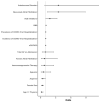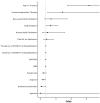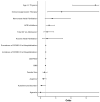Long-Term Mortality after New-Onset Atrial Fibrillation in COVID-19
- PMID: 37109261
- PMCID: PMC10146060
- DOI: 10.3390/jcm12082925
Long-Term Mortality after New-Onset Atrial Fibrillation in COVID-19
Abstract
Background: Atrial fibrillation (AF) has been described as a common cardiovascular manifestation in patients suffering from coronavirus disease 2019 (COVID-19) and has been suggested to be a potential risk factor for a poor clinical outcome. Methods: In this observational study, all patients hospitalized due to COVID-19 in 2020 in the Cantonal Hospital of Baden were included. We assessed clinical characteristics, in-hospital outcomes as well as long-term outcomes with a mean follow-up time of 278 (±90) days. Results: Amongst 646 patients diagnosed with COVID-19 (59% male, median age: 70 (IQR: 59-80)) in 2020, a total of 177 (27.4%) patients were transferred to the intermediate/intensive care unit (IMC/ICU), and 76 (11.8%) were invasively ventilated during their hospitalization. Ninety patients (13.9%) died. A total of 116 patients (18%) showed AF on admission of which 34 (29%) had new-onset AF. Patients with COVID-19 and newly diagnosed AF were more likely to require invasive ventilation (OR: 3.5; p = 0.01) but did not encounter an increased in-hospital mortality. Moreover, AF neither increased long-term mortality nor the number of rehospitalizations during follow-up after adjusting for confounders. Conclusions: In patients suffering from COVID-19, the new-onset of AF on admission was associated with an increased risk of invasive ventilation and transfer to the IMC/ICU but did not affect in-hospital or long-term mortality.
Keywords: COVID-19; atrial fibrillation; outcome.
Conflict of interest statement
The authors declare they have no conflict of interest.
Figures






References
-
- Poterucha T.J., Elias P., Jain S.S., Sayer G., Redfors B., Burkhoff D., Rosenblum H., DeFilippis E.M., Gupta A., Lawlor M., et al. Admission Cardiac Diagnostic Testing with Electrocardiography and Troponin Measurement Prognosticates Increased 30-Day Mortality in COVID-19. J. Am. Heart Assoc. 2021;10:e018476. doi: 10.1161/JAHA.120.018476. - DOI - PMC - PubMed
-
- Russo V., Di Maio M., Mottola F.F., Pagnano G., Attena E., Verde N., Di Micco P., Silverio A., Scudiero F., Nunziata L., et al. Clinical characteristics and prognosis of hospitalized COVID-19 patients with incident sustained tachyarrhythmias: A multicenter observational study. Eur. J. Clin. Investig. 2020;50:e13387. doi: 10.1111/eci.13387. - DOI - PMC - PubMed
LinkOut - more resources
Full Text Sources

